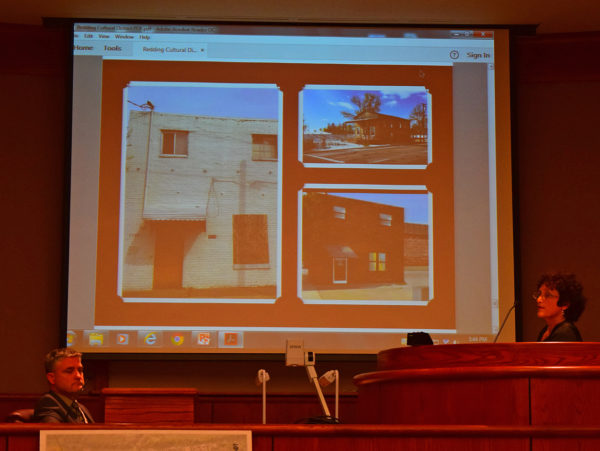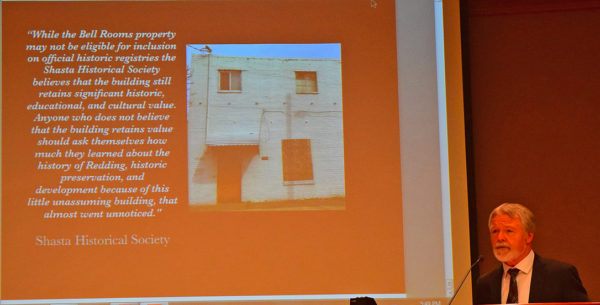
The historic Bell Rooms on the corner of Shasta and California streets in Redding will be demolished. Illustration courtesy of Michael Flanagan.
An impassioned plea by a community coalition seeking a 12-month stay of execution for the 108-year-old Bell Rooms failed to sway the Redding Area Bus Authority board, which voted 4-2 on Monday to demolish the historic brothel at the corner of California and Shasta streets.
The Bell Rooms and the adjoining former Bing’s Automotive and American Lock & Key buildings will be razed to create additional parking for RABA’s downtown transportation center.
The Shasta County Arts Council, in alliance with the Shasta Historical Society and with backing from the philanthropic McConnell Foundation, argued to save the Bell Rooms building.
Debra Lucero, the arts council executive director, told the RABA board that historic structures like the Bell Rooms are not just cool old buildings, they’re economic drivers that can anchor a cultural district, attract creative talent to the downtown area, promote tourism and create jobs.
Lucero cited the arts council, which is headquartered in Old City Hall (which is a year older than the Bell Rooms) as an example of a private-public partnership that flourishes in an historic building.
The Bell Rooms could easily be folded into a downtown cultural district, similar in nature to the Eureka Arts District, Lucero said. Many of the success factors are in place: a unique identity, community support, strong amenities like restaurants and lodging and clear signage.
Besides, “the greenest buildings are the ones that are already built,” Lucero said, noting that Jack’s Grill continues to prosper after 76 years in the same building (which also sported an upstairs brothel back in the ’30s and ’40s).
Millennials are looking for affordable places to live and work and they want to be downtown, Lucero said. “Some may ask, ‘why do we want to save that old whorehouse?’ but to a 30-year-old, they wouldn’t know. Or maybe they’d be intrigued by its past … please hold off and give us a year’s time to come up with something creative and vital.”
Mike Ashby, an attorney with Carr, Kennedy, Peterson & Frost who represents the McConnell Foundation, seconded Lucero’s request for more time to see how the Bell Rooms could be incorporated into downtown Redding’s future.
Besides which, he added, it just doesn’t make sense to demolish the buildings just as work begins on a Downtown Specific Plan, the Diestlehorst-to-Downtown pathway and the project by K2 Development to transform the old Dicker’s department store into a four-story, mixed-use building.
In addition, Ashby said the McConnell Foundation is making progress in its negotiations with Union Pacific Railroad on a potential land swap that would open up the downtown rail yard to a variety of public uses.
“Let’s not be quick to irrevocably wipe them off the map when there’s no compelling reason to do so,” said Ashby, adding that the McConnell Foundation would be willing to make a grant of $5,000 or more to RABA to pay for steel doors and shutters to help secure the Bell Rooms building in the interim.
The Bell Rooms situation came before the RABA board on Aug. 15, at which time the board voted to delay any discussion of demolition plans for two months to allow the Committee to Preserve the Bell Rooms to come up with alternatives.
In his report to the RABA board, Redding Public Works Director Brian Crane said RABA received a $1.1 million state grant to expand the Downtown Transit Center and has spent about $860,000 of it on acquiring property—including the fenced-in parking lot across from the former police station—relocating tenants and preparing for demolition.
The parcel with the Bell Rooms and the two other buildings was purchased for $345,000 and another $172,000 has been spent on it. If the McConnell Foundation, the arts council or any other group were to purchase the Bell Rooms building, RABA would need to recoup about $800,000 in costs, according to Chuck Auklund, the assistant public works director who oversees RABA.
After the historical society first expressed interest in the Bell Rooms, the city hired two consultants, who both concluded the Bell Rooms did not qualify for listing on either the National Register of Historic Places or the California Register of Historic Resources.
Redding Mayor Missy McArthur, who sits on the RABA board, said she supports parks, trails, the arts “and all the amenities that make the community great” but she also supports mass transit and realizes that RABA’s Downtown Transit Center’s space is limited. RABA’s expansion plans have been in the works for four years and the RABA board has to be forward-thinking, she said.
In balancing the future of mass transit against a “this might happen as an arts district” scenario, McArthur said she leans toward the city staff’s recommendation for demolition. Councilwoman Francie Sullivan said she went and looked at the Bell Rooms earlier in the day “and I’m not seeing this is as a building to fall on a sword for.” She questioned the wisdom of spending thousands of dollars to bring the building up to code.
Council members Kristen Schreder and Gary Cadd said they wouldn’t support McArthur’s motion. Schreder said there’s already “lots of regret” over the historic buildings Redding has lost and Cadd said he was satisfied that the preservation committee had mobilized and developed the framework of a plan to save the building.
RABA board members Richard Kern (Shasta Lake City Council) and Norma Comnick (Anderson City Council) expressed concern about RABA’s ability to recoup its expenses and the costs of maintaining the Bell Rooms.
Kern and Comnick joined McArthur and Sullivan in voting for the demolition; Cadd and Schreder cast the dissenting votes. Redding Vice Mayor Brent Weaver was absent and board member David Kehoe recused himself since he also serves on the Shasta Historical Society Board of Directors.
Schreder called the vote “very disappointing.” Following the meeting, Lucero also expressed disappointment. “Guess we’ll have to endure yet another fenced parking lot,” she said. “How does this make more sense than waiting a year until the Downtown Specific Plan takes shape? We’re tearing down our assets before we know the possibilities. It’s really crazy.”
Photos by Jon Lewis.





